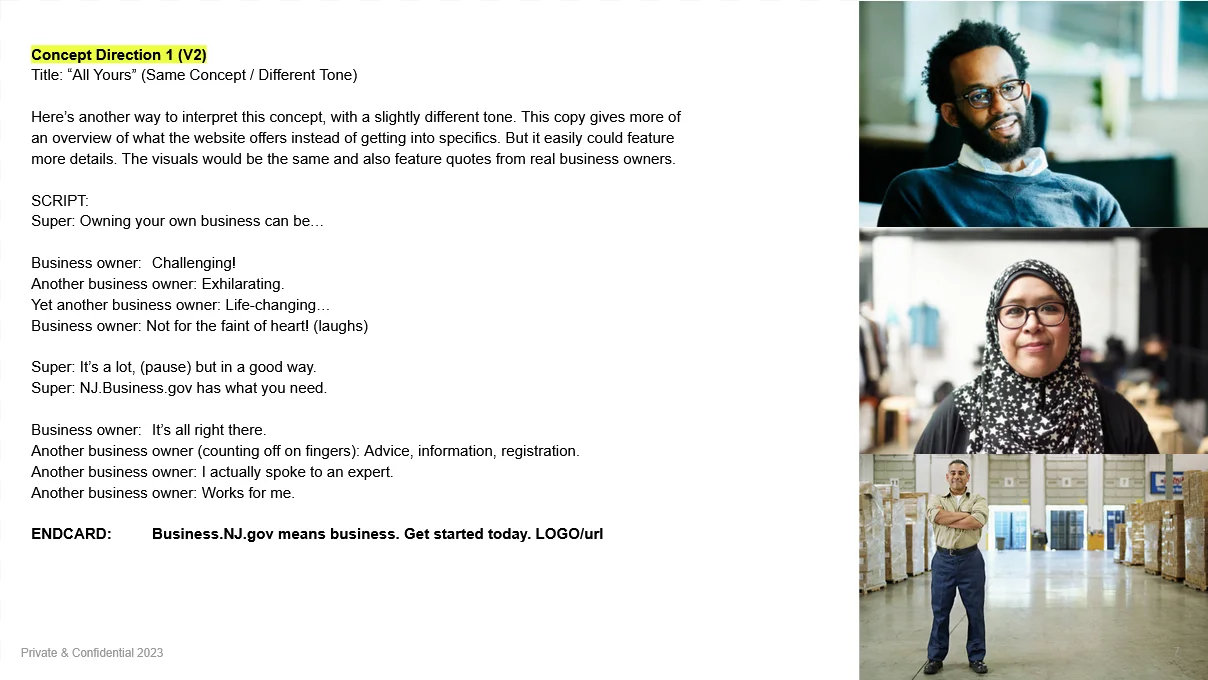
Developing Your Creative Concept(s)
Objectives and strategies are brought to life with messaging and imagery.
During this phase of work, you’ll develop “creative concepts” that fulfill the campaign objectives and the creative strategies defined in your creative brief.
Creative concepts typically consist of some sample copy (such as a headline, call to action, and text) plus imagery (often several photos, illustrations, or other imagery that conveys the emotion the concept is supposed to elicit) that work to bring the idea to life.
Activities include “ideation” (time dedicated to coming up with creative execution ideas, refining them, and rejecting the ones that don’t work) and gathering feedback on the concepts from the team’s stakeholders.
Stakeholder input will help you narrow down the number of creative concept options so the final approved creative concepts can be quantitatively tested and validated.
Why it matters
Good creative execution will activate your audience and move them to action. Poor creative execution will be ignored by your audience and limit your ability to create impact where it is needed most.
How it works
Using the creative brief you developed when defining your strategy, your creative team (typically a copywriter and art director) works together to brainstorm “creative concepts” – which are ideas to capture our audience’s attention with a story that provokes an emotional reaction and moves them to action.
Creative concepts typically consist of some sample copy (such as a headline, call to action, and text) plus imagery (often several photos, illustrations, or other imagery that conveys the emotion the concept is supposed to elicit) that work to bring the idea in the concept to life. Here’s an example.

Creative concepts are not actual ads. They are a device to communicate the key message or idea of your campaign in a compelling and memorable way by invoking emotions, sparking interest, or provoking thought. By having a creative concept phase you are able to react to the idea and impact of an approach, and give feedback into it, before investing the time and effort to develop full-blown ads.
Ideally, you’ll develop a minimum of 4-6 to review internally that will be narrowed down to 3-5 to share with stakeholders. Each concept should offer a different approach and creative idea. It’s important to have a variety of options because it makes it easier to identify what you like and don’t like, and you may find elements across the individual concepts that you want to draw from.
You’ll then share the concepts with your project stakeholders for their feedback. Feedback from your stakeholders should focus on strategic direction (i.e., can we dial up the emotion, can the call to action be made more prominent, etc). While it’s tempting to give executional feedback (i.e., change the headline to blue because I don’t like green) it’s important to let the creative team handle these details.
Based on feedback, you’ll narrow down your concepts as you won’t want to test more than three or four. If you’re not able to test your creative concepts, you’ll need to select one to move forward with.
Before moving the concepts into validation, you should consider if you want to test the concepts as presented with visuals and copy, or if they should be further developed into 30 second scripts. If your campaign is taking a “video-first” approach, where video will be the lead creative asset and used across multiple channels and formats (such as TV, streaming, paid social, on websites/microsites, and in emails), you will get the best learning with a script.
How long it takes
1–3 weeks.
Good ideas can happen in a few minutes or take some time to ferment.
If possible, it’s good to give your creative team time to develop their ideas, especially if your message is especially complicated or nuanced.
Don’t forget to allocate time for feedback. But remember, the more you “noodle” with the work with repeated small changes that don’t impact the quality of the work, the longer it will take to finalize your creative concepts.
Do it in a day
Ideation can be time-boxed. Give your team a day and see what they come up with. While this isn’t recommended for a campaign that will be running for a while and has a significant media budget, it will absolutely work for quick-turnaround projects and/or one-off efforts.
Pro Tip
If you don’t have a creative team, it is highly recommended you find an experienced creative resource to do this work (see Kick-off meeting).
Outputs
- Creative concept presentation deck
 Office of Innovation
Office of Innovation